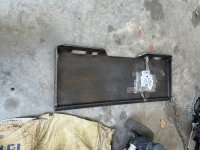aczlan
Good Morning!
ThePanzerFuhrer should know better than most anyone else on here, I know I have seen a lot of older equipment with grade 5 bolts in place of pins...Loader Pin Material.... drilled for grease applications.
I picked up a EARLY version of a Bobcat 331. Its in the first 2k units produced while still under Melroe. Runs like a champ, has some hydraulic issues that are easy to fix for the most part, but the pins are bad... like throwing a hot dog down the hallway.
I've got access to someone who can Line Bore it (supposedly) and can make my own bushings on the lathe and can rebore the rod eyes that the bushings were worn out so far that the rod eye is now being beat up... all of that can be done in my little shop.
But... as for the pins. I've got an old farmer friend barking in my ear that I absolutely have to use hardened ground pins otherwise I'll shear one off or bend one and then never get it back out without drilling the ends out with a mag drill or something up to the shear plane.
I've got another friend saying that since I'll be upsizing the pin diameter in the re-pin process that I can probably get away with just machining 1144, especially since it needs to be bored and cross drilled for grease application.
Experience and thoughts? Sources for nominal size ground pins? Etc?

Aaron Z



